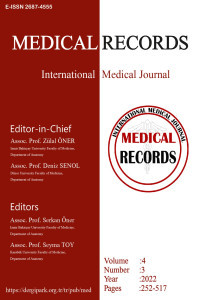Ultrastructural Changes and Inflammatory Processes of Day-Dependent Cisplatin Administration on Rat Cardiac Tissue
Ultrastructural Changes and Inflammatory Processes of Day-Dependent Cisplatin Administration on Rat Cardiac Tissue
Cardiotoxicity, cisplatin, inflammation, mitochondrial damage, ultrastructure,
___
- 1. Kim CW, Choi KC. Effects of anticancer drugs on the cardiac mitochondrial toxicity and their underlying mechanisms for novel cardiac protective strategies. Life Sci. 2021;277:119607.
- 2. Qi L, Luo Q, Zhang Y, et al. Advances in toxicological research of the anticancer drug cisplatin. Chem Res Toxicol. 2019;32:1469-86.
- 3. Dugbartey GJ, Peppone LJ, de Graaf IA. An integrative view of cisplatin-induced renal and cardiac toxicities: molecular mechanisms, current treatment challenges and potential protective measures. Toxicology. 2016;371:58-66.
- 4. Chowdhury S, Sinha K, Banerjee S, et al. Taurine protects cisplatin induced cardiotoxicity by modulating inflammatory and endoplasmic reticulum stress responses. Biofactors. 2016;42:647-64.
- 5. Costa VM, Carvalho F, Duarte JA, et al. The heart as a target for xenobiotic toxicity: the cardiac susceptibility to oxidative stress. Chem Res Toxicol. 2013;26:1285-311.
- 6. Demkow U, Stelmaszczyk-Emmel A. Cardiotoxicity of cisplatin-based chemotherapy in advanced non-small cell lung cancer patients. Respir Physiol Neurobiol. 2013;187:64-7.
- 7. Ma H, Jones KR, Guo R, et al. Cisplatin compromises myocardial contractile function and mitochondrial ultrastructure: role of endoplasmic reticulum stress. Clin Exp Pharmacol Physiol. 2010;37:460-5.
- 8. El-Awady el-SE, Moustafa YM, Abo-Elmatty DM, et al. Cisplatin-induced cardiotoxicity: mechanisms and cardioprotective strategies. Eur J Pharmacol. 2011;650:335-41.
- 9. Bayrak S, Aktaş S, Altun Z, et al. Antioxidant effect of acetyl-l-carnitine against cisplatin-induced cardiotoxicity. J Int Med Res. 2020;48:300060520951393.
- 10. Clark JD, Gebhart GF, Gonder JC, et al. Special report: the 1996 guide for the care and use of laboratory animals. ILAR J. 1997;38:41-8.
- 11. El-Hawwary AA, Omar NM. The influence of ginger administration on cisplatin-induced cardiotoxicity in rat: Light and electron microscopic study. Acta Histochem. 2019;121:553-62.
- 12. Oun R, Rowan E. Cisplatin induced arrhythmia; electrolyte imbalance or disturbance of the SA node?. Eur J Pharmacol. 2017;811:125-8.
- 13. Wang D, Lippard SJ. Cellular processing of platinum anticancer drugs. Nat Rev Drug Discov. 2005;4:307-20.
- 14. Ma W, Wei S, Zhang B, et al. Molecular mechanisms of cardiomyocyte death in drug-induced cardiotoxicity. Front Cell Dev Biol. 2020;8:434.
- 15. Sancho-Martínez SM, Prieto-García L, Prieto M, et al. Subcellular targets of cisplatin cytotoxicity: an integrated view. Pharmacologic Ther. 2012;136:35-55.
- 16. Choi YM, Kim HK, Shim W, et al. Mechanism of cisplatin-induced cytotoxicity is correlated to impaired metabolism due to mitochondrial ROS generation. PLoS One. 2015;10:e0135083.
- 17. Varga ZV, Ferdinandy P, Liaudet L, Pacher P. Drug-induced mitochondrial dysfunction and cardiotoxicity. Am J Physiol Heart Circ Physiol. 2015;309:H1453-67.
- 18. Qian P, Yan LJ, Li YQ, et al. Cyanidin ameliorates cisplatin-induced cardiotoxicity via inhibition of ROS-mediated apoptosis. Exp Ther Med. 2018;15:1959-65.
- 19. Ueki M, Ueno M, Morishita J, Maekawa N. Curcumin ameliorates cisplatin-induced nephrotoxicity by inhibiting renal inflammation in mice. J Biosci Bioeng. 2013;115:547-51.
- 20. Xing JJ, Hou JG, Liu Y, et al. Supplementation of saponins from leaves of Panax quinquefolius mitigates cisplatin-evoked cardiotoxicity via inhibiting oxidative stress-associated inflammation and apoptosis in Mice. Antioxidants (Basel). 2019;8:347.
- 21. Zhou YD, Hou JG, Yang G, et al. Icariin ameliorates cisplatin-induced cytotoxicity in human embryonic kidney 293 cells by suppressing ROS-mediated PI3K/Akt pathway. Biomed Pharmacother. 2019;109:2309-17.
- 22. El-Sawalhi MM, Ahmed LA. Exploring the protective role of apocynin, a specific NADPH oxidase inhibitor, in cisplatin-induced cardiotoxicity in rats. Chem Biol Interact. 2014;207:58-66.
- 23. Bin Naeem S, Azhar M, Baloch NU, et al. Cisplatin-induced bradycardia: a silent risk observed in two different clinical cases. Cureus. 2021;13:e19769.
- 24. H S Darling. Cisplatin induced bradycardia. Int J Cardiol. 2015;182:304-6.
- Yayın Aralığı: Yılda 3 Sayı
- Başlangıç: 2019
- Yayıncı: Zülal ÖNER
Anıl ALTIPARMAK, Muhammed Furkan ARPACI, Merve AYDIN, Feyza İNCEOĞLU, Hıdır PEKMEZ
Evaluation of Poisoning Cases Presenting to the Pediatric Emergency Department
İlknur KABA, Samet Can DEMİRBAŞ, Havva Nur Peltek KENDİRCİ
MATERNAL BISPHENOL-A'NIN SIÇAN BÖBREK GELİŞİMİ ÜZERİNDEKİ ETKİSİNİN İNCELENMESİ
Dilek MEYDAN, Semih TAN, Saim ÖZDAMAR, Hülya ÇETİN
Mahmut Zabit KARA, Mehmet Hamdi ÖRÜM, Ayşe Sevgi KARADAĞ, Aysun KALENDEROĞLU
Ahmet YABALAK, Muhammed Nur ÖĞÜN
Evaluation of the Effect of COVID-19 on Patients Undergoing Orthodontic Treatment
Hilal YILANCI, Kevser KURT DEMİRSOY, Barış CANBAZ, Servet BOZKURT, Duygu SEVGİ
lncRNA MALAT1, MEG3, and PANDAR Levels may be Potential Diagnostic Biomarkers in Multiple Myeloma
Elvin ERÖKSÜZ ÖZDİNÇ, Kuyaş HEKİMLER ÖZTÜRK, Fadime MUTLU İÇDUYGU, Demircan ÖZBALCI
Selim ÇINAROĞLU, Hasan AKKAYA, Hacı KELEŞ, Fatih ÇİÇEK
Invention Arising From Surgical Service Needs; Stoma Bag Cover
